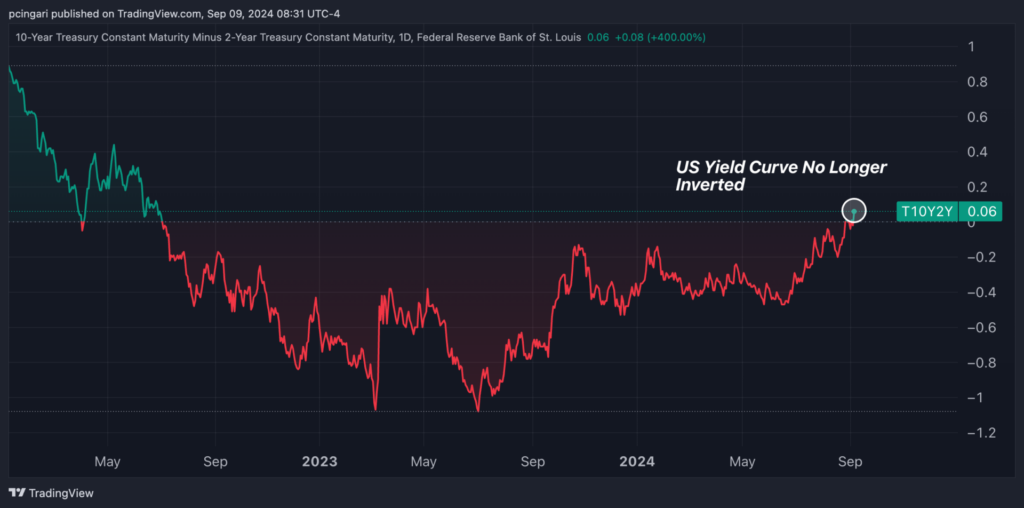Zinger Key Points
- The U.S. yield curve has exited inversion, with the 10-year Treasury yield now at 3.72% and the 2-year at 3.65%.
- Historical precedent suggests that yield curve inversions typically signal recessions, but this time could be different, as noted by veteran
- Pelosi’s latest AI pick skyrocketed 169% in just one month. Click here to discover the next stock our government trade tracker is spotlighting—before it takes off.
The U.S. Treasury yield curve officially exited its prolonged inversion on Friday, Sept. 6. This marks the end of over two years when short-term yields were higher than those on long-term bonds — a rare and closely watched economic phenomenon.
As of Monday, the 10-year Treasury yield stood at 3.72%, with the two-year at 3.65%. That’s a spread of 7 basis points (bps). The question now is what this shift means for the economy, markets, and Federal Reserve policy.
Why Yield Curve Inversions Matter
Under normal conditions, longer-term bonds tend to offer higher yields than shorter-term ones because of the increased risk and uncertainty over time. Investors expect to be compensated for tying up their money for a longer period.
The longer you commit your money, the greater the potential for economic shifts, inflation, or interest rate changes that could erode returns.
However, when the yield curve inverts, the opposite happens. Short-term bonds, like the 2-year Treasury, yield more than longer-term bonds, such as the 10-year Treasury. This unusual scenario reflects a pessimistic outlook from investors, who expect near-term economic challenges and are betting that tighter monetary policy will slow down growth.
For the past 24 months, the 2-year Treasury yield has consistently traded above the 10-year. Markets anticipated that the Federal Reserve's aggressive interest rate hikes would cool down the economy — potentially to the point of triggering a recession.
Historically, this inversion has been seen as a harbinger of recession. Since the 1970s, every U.S. recession has been preceded by an inverted yield curve.
Chart: US Yield Curve Exits Four-Year Inversion

What Triggered The Shift?
The end of the inversion came in response to the weaker-than-expected jobs data from the August nonfarm payrolls report.
Coupled with other recent subdued economic data, the Federal Reserve is poised to begin cutting interest rates this month.
“Fixed-income investors are increasingly aligning with our view that the U.S. economy won't slip into a recession, especially now that the Fed seems committed to easing its policy to avert one,” said Ed Yardeni, a veteran Wall Street strategist and founder of Yardeni Research.
What An Univerted Yield Curve Means: Why Is This Time Different?
With the 2-year yield falling back below the 10-year, markets are pricing in a relatively aggressive path of rate cuts by the Federal Reserve.
Fed futures are currently pricing in nearly 90 basis points of rate cut by year end, according to CME FedWatch.
Easier monetary policy is expected to boost economic growth, but it also raises the risk that inflation could heat up again.
As a result, the yield curve could steepen further once the Fed starts reducing short-term rates.
As Ed Yardeni highlighted, “In the past, inverted yield curves were often leading indicators of recessions. When they started to disinvert, recessions often followed quickly.”
However, Yardeni also emphasized that the current economic situation is different. Last year's mini-banking crisis, which many feared would lead to a credit crunch, did not result in a recession or widespread credit tightening.
According to Yardeni, the yield curve could steepen significantly without a recession materializing, especially as the Fed transitions to an easing cycle. In past cycles, the spread between the 2-year and 10-year peaked at an average of 220 bps, with a range between 161 bps and 290 bps. If the 2-year yield bottoms around 3.00% during this easing cycle, the 10-year yield could rise to 5.20%, significantly above its current level of 3.72%.
“There are many ways to play the yield-curve forecasting game,” Yardeni said. “We believe the neutral two-year yield is around 3.00%, and the neutral 10-year yield is closer to 4.00%.
What's Next?
For investors, the end of the inversion signals a shift in market sentiment. The bond market now expects the Fed to prioritize growth over inflation, betting on a softer economic landing than previously feared.
Yes, bond investors should keep an eye on potential inflationary risks. However, the flattening and eventual steepening of the curve suggest a more stable economic outlook.
The yield curve's disinversion might not completely eliminate recession risks. But, for now, markets appear to be betting on a more favorable outcome—a cooling economy without a hard crash
Now Read:
Image: Shutterstock
© 2025 Benzinga.com. Benzinga does not provide investment advice. All rights reserved.
Trade confidently with insights and alerts from analyst ratings, free reports and breaking news that affects the stocks you care about.